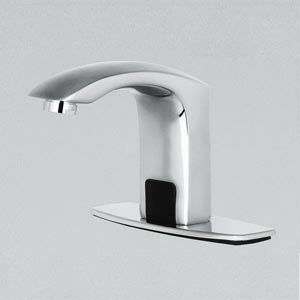Commercial Touchless & Automatic Soap Dispensers
Touchless faucets are used in commercial public bathrooms to help conserve water and reduce the spread of germs from one person to another.Touchless soap dispenser would create a more hygienic restroom space. Soap dispensers are a vital part in any commercial area and their frequent use means that they require maintenance as often. Most restaurants have now shifted to the use of automatic or touchless soap dispensers as a logical solution to the problem of constant damage. An
Automatic soap dispenser is a relatively recent development. These soap dispensers, as the name suggests, automatically dispenses a fixed amount of soap when the presence of hands is detected by its presence sensors
. Such automatic washroom technology is gaining popularity for commercial use because of its user-friendliness, hygiene-friendliness and contribution to conservation.
Types of automatic and touchless soap dispensers
The different types of soap dispensers that exist are different in terms of the sensors they make use of. The rest of the working is more or less the same.
-
Photo sensor
These soap dispensers use a
light source and a sensor to detect the presence of light. The emitter/light source emits a focused ray that the sensor detects. When the hands come in the way of this light ray, the path will be disrupted and it is this disruption that the sensor will respond to. So, in the presence of hands, the pump will activate and the soap will be dispensed.
-
Passive infrared sensor
The passive infrared sensors make use of sensors that detect the presence of infrared rays. Thus, the infrared rays emitted by the hands will be detected by these sensors and this will activate the pump. So, when hands are brought under the nozzle of the soap dispenser, the soap is dispensed because the sensor activated the pump.
-
Radar-based sensor
This type of soap dispenser uses micro-waves. The source of micro-wave emissions emits micro-wave which can reflect off irregular surfaces. When hands are brought under the nozzle, the micro-waves reflect back and are detected by a sensor. This happens because the human skin counts as an irregular surface that reflects back micro-waves. Other such soap dispensers make use of infrared radiation for the same purpose. These use infrared emitter and collectors. The
soap is dispensed when the rays are reflected back to the collector.
Here are some such automatic soap dispenser products available in the market:
|
|

|
|
1. Fontana Hugo Commercial Oil Rubbed Bronze Automatic Hands Free Faucet
2. Fontana Commercial Automatic Hands Free Chrome Finish Sensor Faucet
Commercial Touchless Soap Dispenser Features
All types of commercial touchless soap dispensers have similar features and mostly, the only difference is the type of the sensor used. The common features are the sensor, pump, nozzle and the soap container. The nozzle and the soap container are present in all soap dispensers; automatic or otherwise. The sensor is meant to detect the presence of hands and the pump dispenses the soap. The sensor activates the pump when hands are brought under the nozzle.
3. Fontana Reno Deck Mount Hands Free Commercial Automatic Soap Dispenser
|
|

|
|
Benefits of commercial automatic soap dispensers
-
Hygiene-friendliness
The alternative of automatic soap dispensers are bars of soap or other non-automatic soap dispensers. In case of these for commercial use, contamination through contact is a major problem. The necessity of contact with the technology ruins the hygienic role of hand washing. By contact, germs can easily be transmitted from the hands of one user to those of the other. This is particularly problematic in commercial settings and public place like restaurants and plazas. All soap technologies except the automatic soap dispensers can lead to bacterial transmission. Without the need to make contact with the device, touchless soap dispensers eliminate the risk of contamination.
-
Prevention of soap wastage
In public settings where one cannot monitor the amount of soap that is being used, wastage is a particular problem. The touchless soap dispenser automatically dispenses only as much soap as is necessary for a regular hand-wash and this minimizes wastage.
Where they can be used
Because of its hygiene-friendliness and its role in prevention of wastage, this technology is particularly useful in commercial settings like in the washrooms of restaurants, gyms, hotels or plazas.
Durability and ease of use
Since there is no need to make contact with the device, using the touchless soap dispenser is easy. At the same time, it reduces risk of damage and thereby reduces maintenance costs. These soap dispensers are thus durable and easy to use.
|
|

|
|
|